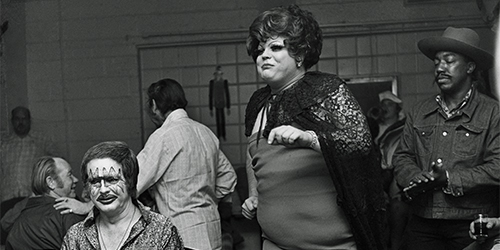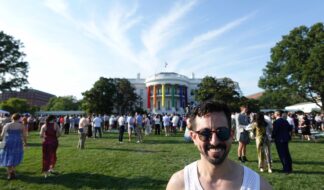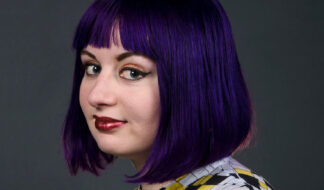By Chene Koppitz

Bruce Harknessas aHalloween Party, Verdias Bar, Sibley Street, 1977a
Despite having a verifiable population under one million residents, Detroit has been in the forefront of national and international news for the past decade. The city's rich history, as well as its impoverished present, brought visitors from across the globe to the Motor City for a variety of reasons, from investment to photographic documentation.
In 2010, Yves Marchand and Romain Meffre published "The Ruins of Detroit," a book of photo-essays documenting the city's decline, which reinvigorated the concept of "ruin porn" photography. Introduced in the mid-1990s by another visiting photographer, "ruins photography" or "ruin porn" is best understood as taking pictures of once grand, now decrepit, buildings and public spaces, usually with artistic or documentary intent. While the genre was initially embraced, both here in Detroit and elsewhere, the trend has lost traction as the city begins to slowly reinvent itself. Nowhere is this renaissance more evident than "CardioVista: Detroit Street Photography," an exhibition of photo-essays opening on Friday, Jan. 16 at the Alfred Berkowitz Gallery on the University of Michigan-Dearborn campus. Shot over five concurrent decades by four local photographers, the exhibit documents not only the Detroit that was – and, in some cases, no longer remains – but what the city may well become in the future.
Of particular interest to the LGBTQI community is Bruce Harkness's series on Cass Corridor. Shot largely in the late 1970s, these black and white photos show people and places few Detroit area residents knew existed, then or now. Despite being in black and white, Harkness captures the vibrancy and warmth of Detroit's Gay Bar culture through a number of photos taken at the Gold Dollar Show Bar. Shuttered in the early 2000s, the Gold Dollar had more recently been home to several of Detroit's most successful indie bands (White Stripes, Electric Six), but its legacy as a drag bar was well known to the later music crowd. In "Lisette, Gold Dollar Show Bar, 1977," a gorgeous drag queen literally spills off the stage as she looks distractedly over her shoulder. "Halloween Party, Verdi's Bar, Sibley Street, 1977" finds a rainbow crowd of revelers, complete with a sassy queen and a lame-shirted man sporting Kiss-inspired face paint, celebrating Oct. 31 in pure Motown style. A more intimate look at Detroit queer life is seen in "Ron and Art, Spaulding Court Apartments, 1978." This portrait of a same-sex couple in their home, surrounded by spectacular mid-70s decor, is beautiful because of its simplicity and the subjects' naturalness. That Harkness, a straight man with no connections within the community, could gain access to such spaces in an era where most gay citizens were targeted for violence speaks volumes to the depth of his work, here and in other essays.
The other artists – Brian Day, Carlos Diaz and Tom Stoye – explore a variety of subjects, from graffiti culture to Detroit's stunning architecture, in ways that challenge the viewer to rethink not only street photography but also the city of Detroit and its surrounding suburbs. The exhibit was curated by Associate Professor of Art History Nadja Rottner, who has long been interested in city spaces, urban topography and the ways and means in which visual and cultural histories are documented. "CardioVista: Detroit Street Photography" offers the viewer another way of seeing the Motor City that involves more than photos of Michigan Central Station or the Packard Plant. As Brian Day so deftly noted, "I've seen that already. Show me something else."
"CardioVista: Detroit Street Photography" opens on Friday, Jan. 16 with an artists' reception from 5-7:30 p.m. at the Alfred Berkowitz Gallery, located on the third floor of the Mardigian Library on the University of Michigan-Dearborn campus. Brian Day, Carlos Diaz, Bruce Harkness and Tom Stoye will be in attendance and a catalog of the exhibit will be offered for sale. The event is free and open to the public. The show will run 9 a.m.-4 p.m. on Monday-Friday through Friday, March 13.










